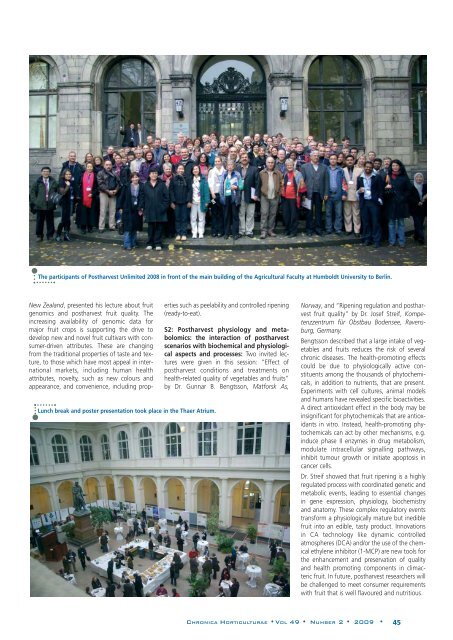Chronica Horticulturae volume 49 number 2 ... - Acta Horticulturae
Chronica Horticulturae volume 49 number 2 ... - Acta Horticulturae
Chronica Horticulturae volume 49 number 2 ... - Acta Horticulturae
Create successful ePaper yourself
Turn your PDF publications into a flip-book with our unique Google optimized e-Paper software.
The participants of Postharvest Unlimited 2008 in front of the main building of the Agricultural Faculty at Humboldt University to Berlin.<br />
Lunch break and poster presentation took place in the Thaer Atrium.<br />
New Zealand, presented his lecture about fruit<br />
genomics and postharvest fruit quality. The<br />
increasing availability of genomic data for<br />
major fruit crops is supporting the drive to<br />
develop new and novel fruit cultivars with consumer-driven<br />
attributes. These are changing<br />
from the traditional properties of taste and texture,<br />
to those which have most appeal in international<br />
markets, including human health<br />
attributes, novelty, such as new colours and<br />
appearance, and convenience, including properties<br />
such as peelability and controlled ripening<br />
(ready-to-eat).<br />
S2: Postharvest physiology and metabolomics:<br />
the interaction of postharvest<br />
scenarios with biochemical and physiological<br />
aspects and processes: Two invited lectures<br />
were given in this session: “Effect of<br />
postharvest conditions and treatments on<br />
health-related quality of vegetables and fruits”<br />
by Dr. Gunnar B. Bengtsson, Matforsk As,<br />
Norway, and “Ripening regulation and postharvest<br />
fruit quality” by Dr. Josef Streif, Kompetenzzentrum<br />
für Obstbau Bodensee, Ravensburg,<br />
Germany.<br />
Bengtsson described that a large intake of vegetables<br />
and fruits reduces the risk of several<br />
chronic diseases. The health-promoting effects<br />
could be due to physiologically active constituents<br />
among the thousands of phytochemicals,<br />
in addition to nutrients, that are present.<br />
Experiments with cell cultures, animal models<br />
and humans have revealed specific bioactivities.<br />
A direct antioxidant effect in the body may be<br />
insignificant for phytochemicals that are antioxidants<br />
in vitro. Instead, health-promoting phytochemicals<br />
can act by other mechanisms, e.g.<br />
induce phase II enzymes in drug metabolism,<br />
modulate intracellular signalling pathways,<br />
inhibit tumour growth or initiate apoptosis in<br />
cancer cells.<br />
Dr. Streif showed that fruit ripening is a highly<br />
regulated process with coordinated genetic and<br />
metabolic events, leading to essential changes<br />
in gene expression, physiology, biochemistry<br />
and anatomy. These complex regulatory events<br />
transform a physiologically mature but inedible<br />
fruit into an edible, tasty product. Innovations<br />
in CA technology like dynamic controlled<br />
atmospheres (DCA) and/or the use of the chemical<br />
ethylene inhibitor (1-MCP) are new tools for<br />
the enhancement and preservation of quality<br />
and health promoting components in climacteric<br />
fruit. In future, postharvest researchers will<br />
be challenged to meet consumer requirements<br />
with fruit that is well flavoured and nutritious.<br />
CHRONICA HORTICULTURAE •VOL <strong>49</strong> • NUMBER 2 • 2009 • 45
















